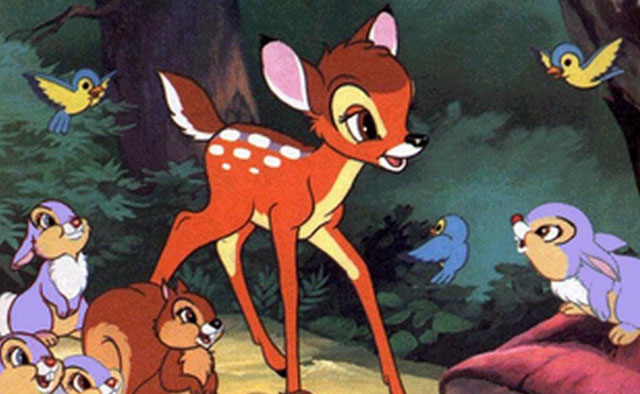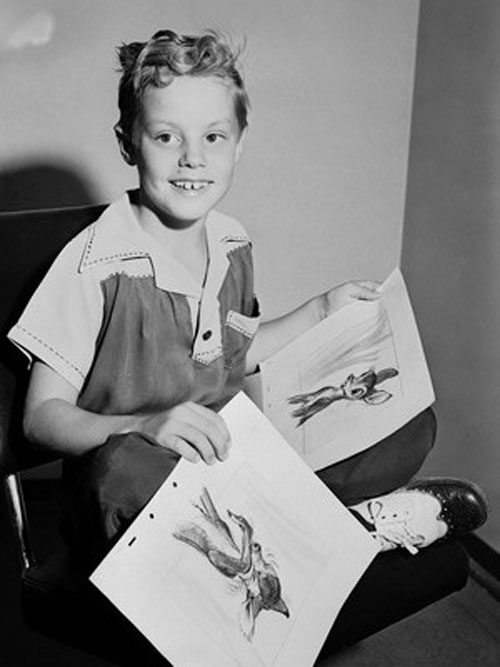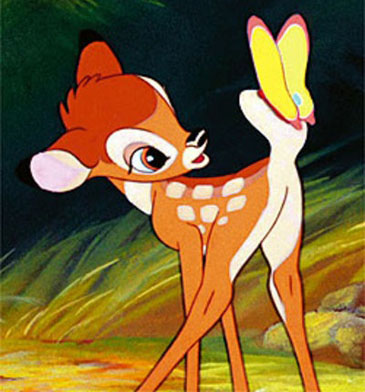CHICAGO – Excelsior! Comic book legend Stan Lee’s famous exclamation puts a fine point on the third and final play of Mark Pracht’s FOUR COLOR TRILOGY, “The House of Ideas,” presented by and staged at City Lit Theater in Chicago’s Edgewater neighborhood. For tickets/details, click HOUSE OF IDEAS.
Interviews: Voice of Young ‘Bambi’ Donnie Dunagan
CHICAGO – “Bambi” maintains its impact nearly 70 years after debuting in 1942. Walt Disney Studios releases the Blu-ray Diamond Edition DVD of the film on March 1st, and the voice of Young Bambi, Donnie Dunagan, was in Chicago with animator Andreas Deja to talk about it.
Dunagan is an intriguing footnote to the Bambi legend, not credited initially as the voice of the young fawn. It was his last film performing job – at the age of seven – after a whirlwind of child actor roles, including the title character in “Son of Frankenstein” (1939). World War II changed his circumstances, and he went on to a military career that included tours of duty in the Korean and Vietnam conflicts. Dunagan has a gregarious, larger-than-life presence, with a crystal clear memory.
 Photo Credit: © Walt Disney Studios |
Andreas Deja was the key animation and restoration consultant on this latest edition of Bambi, and his story in connection to the Walt Disney Studios is just as unique as Dunagan’s. As a ten year old boy in Germany, he wrote the Disney studio to apply for a job after seeing “The Jungle Book.” This began a relationship that led to his first job in animation with Disney ten years later. One of his early mentors was Eric Larson, one of the original “nine old men,” who worked on the first Disney features – including Bambi – in the late 1930s.
Dejas worked initially on “The Black Cauldron” (1985), and it was the tepid response to this film that nearly closed the animation department. But Dejas also experienced the new golden age of Disney, working on “Beauty and the Beast” (1991) and “The Lion King” (1994), as well as the legendary “Who Framed Roger Rabbit?” (1988). He continues his role as supervising animator and oversaw the restoration of the new Blu-ray edition of Bambi.
HollywoodChicago.com spoke with both “Men of Bambi,” during their promotional tour on February 22th in Chicago. Their stories and insight on this enduring animated classic, combined with their own journeys, created this fascinating discussion.
 Donnie Dunagan, Voice of “Young Bambi”
Donnie Dunagan, Voice of “Young Bambi”
 Photo credit: © Walt Disney Studios |
HollywoodChicago.com: You are often asked, no doubt, about memories that occurred 70 years ago. Was it enough excitement, with the cameras, microphones and adults milling about, to maintain the memories or did relatives help you remember the stories over the years?
Donnie Dunagan: I was reading newspapers at age four, and my memory goes back to age three and a half crisply. That is both good and bad. [laughs] I remember Disney and Bambi because it was my seventh film, and the two just proceeding that, when I was a child on a sound stage, was very boring. I had approached my mother and asked her if I could quit after the sixth film. I had done six films in less than two years, and my childhood was gone. I wanted to go to the circus and go fishing.
I think my mother was about to agree to that, even though before the films we were dirt poor. She agreed, my Dad agreed, and several months elapsed from my last film until the call from Disney. When Disney called, I thought we’d won something big in a contest, my mother was so excited. I knew about Disney, because that is where all the fun people were. I couldn’t wait to go.
HollywoodChicago.com: What happened when you arrived?
Dunagan: When I finally went I was not disappointed. It was so exciting, so much more fun than the sound studios. Except I didn’t understand the storyline, and I was initially hired to also be the facial model for Bambi. But the voice work turned out to be great.
And I was almost fired. When I worked on ‘Son of Frankenstein,’ Boris Karloff [who portrayed ‘The Monster’] gave me a water pistol for Christmas, and I kept it from my Mom. There was a terrible guy at Disney, as compared to all the other great people, and I called this guy ‘Grump.’ One day in the hallway I hid behind the corner, and got two big shots at the Grump with my magnificent water pistol. He went crazy, and a Disney executive was behind me and saw the whole thing. He must have thought the guy was a Grump as well, because he told me to get out of there. Later, the security guys came and took the water pistol away from me. This is not funny. It’s 70 years later and I want that thing back. [laughs]
HollywoodChicago.com: You literally played a title character in the golden movie year of 1939 as the “Son of Frankenstein.” What in your crystal clear memory comes back to you about that experience?
Dunagan: I was five years old, and it was my second film. For openers, Boris Karloff could have been a stand-up comic. Boris Karloff was the most popular man on the set. He taught me how to play checkers. We played for quarters, and since he got so distracted I actually won a game. The next day, I won again, and now he owes me two quarters. He was so teased by the crew that he got out of his chair in full monster make-up, went to his dressing room, and came out with a silver dollar. I was waiting for my money, the guys were giving him a hard time. When he presented the dollar to me, I thought it was funny money, I’d never seen a silver dollar. And I wouldn’t take it. Even Basil Rathbone [Dr. Frankenstein] was laughing.
So Karloff got on his knee and said, ‘take this Donnie, it’s real money.’ If I had a picture of that I could double retire right now. [laughs]
 Photo credit: Universal Pictures |
HollywoodChicago.com: What were the circumstances of you leaving Hollywood and show business after doing the Bambi voiceover. Was it simply a family situation?
Dunagan: It was a combination of that and World War II, which changed the country more profoundly than you can imagine. There were troops within Disney Studios weeks after Pearl Harbor, for obvious reasons. The war broke up my family, there were some deaths, and I don’t enjoy talking about that much anymore. From age 13 and a half I was in a boarding house supporting myself. What I learned was like forging metal, it has served me well ever since.
I never looked back upon my Hollywood days from the age of 14 to about five years ago. My wife didn’t even know until two years after we were married. I was in the Marine Corp for 25 years, and one officer – because he had my FBI file – knew about it. At the end of my military career, a general found out about and made me do an additional duty in association with it that I didn’t want to do. He called me ‘Major Bambi.’ [laughs]
HollywoodChicago.com: Since you participated in the Vietnam conflict with boots on the ground, what in your perspective was the primary failure of that war to win both the hearts and minds of the Vietnamese people and the hearts and minds of the American people?
Dunagan: I studied it intensely. We didn’t have a sense of the culture when we entered, and we barely had a sense when we left. In the interim eight miserable years, and all the losses, we should have paid more attention to the people in the hinterland, the interior.
In my first tour, after I had graduated from the Presidio language school – Vietnamese is a very difficult language – I spoke enough to communicate. I sensed right away, since I never was around the big cities and maneuvered all the time in the interior, that the leaders of these hamlets and villages wanted the government in Saigon out of there. Our mission was to defend that government, that was my charter. All I heard in country was that the main government was not supported, and it intensified on my second tour. The other officers and I would talk candidly about it.
When Walter Cronkite, who I admired morally and intellectually, when he finally contributed to closing that thing down, I sent him a telegram. ‘Thank you sir, thank you for helping this country.’
 Andreas Deja, Restoration Consultant for the Diamond Edition of “Bambi”
Andreas Deja, Restoration Consultant for the Diamond Edition of “Bambi”
Photo Credit: Patrick McDonald for HollywoodChicago.com |
HollywoodChicago.com: As a restoration consultant on this vital piece of film history, what did you primarily want to do differently in your approach to making sure the intention of the original animators was in the re-doing for modern technologies like Blu-Ray?
Andreas Deja: It was an interesting process, which doesn’t differ from one restoration project to another. We start out by going back to the original negative, and those are really old and starting to fall apart. So the process of digitizing each image is really saving the film. We scan each frame, and then look for possible damage – scratches, dirt and spots. We paint those out, to get it nice, even and clean.
Then when we see these images in high definition, we began to see some painting mistakes, quite a few actually, that you don’t see on 35mm film – the grain tends to blend the images and hide the mistakes. For example, Bambi’s toe, which is dark brown, may have ended up a skin tone. So we take those mistakes out and paint it to match the rest of the frames. It takes about seven or eight sessions of viewing the film to understand what to restore and what to leave alone.
One of the most important things is to keep the colors intact. We go back to the original backgrounds and make sure the movie is in line with the original artwork and we preserve the animator’s intent.
HollywoodChicago.com: You were trained by one of the animators that worked on the original film…
Deja: Eric Larson, who trained me, was one of the four supervising animators on Bambi. He animated The Owl character, and in later life looked like The Owl, [laughs] in both the roly-poly look and the grandfatherly wisdom. He was amazing. He was the one that was head of the animation program when I started in the 1980s. He trained people like John Lassiter and Brad Bird, all these famous animators now, who went through his training program.
I first heard of Eric Larson studying an animation book when I was a boy in Germany. I wrote him, and he actually wrote back. We had a nice exchange of letters, and he also visited me in Germany while on a vacation cruise. My English at the time was terrible, but here was this wise, legendary man of Disney telling me all these secrets of animation. It was frustrating because I tried to understand what he was saying, but I could only get about half of it. [laughs] He did hire me eventually, after art school, and I entered his training program in 1980.
 Photo credit: © Walt Disney Studios |
HollywoodChicago.com: What aspect of the original animation most moved you emotionally when you were in the process of the Bambi restoration?
Deja: The sincerity of the animation. It wasn’t really showing off, but these guys did their homework. Not just skeletons, but the movements of real deers, skunks and rabbits. They had a way of using that knowledge and making these animals real. Animating them with such dignity and poetry, when Bambi walks it is to the beat of the music, and there is something lyrical about that. There is no other studio in the world besides Disney who could do that back then.
HollywoodChicago.com: You joined Disney right around the time of The Black Cauldron, the film that almost closed the animation department. What was the atmosphere at the time of the edge of that possible elimination and how satisfying was it 10 years later when Beauty and the Beast was nominated for Best Picture?
Deja: It was an interesting time when I started, but I couldn’t compare it to anything else because it was my first job. But something in the studio felt a little funny because all these young people were coming in from different art studios and they all had an idea as to where Disney should go. Ideas ranged from the style of the 1940s, the graphic style of the 1960s and just start over with a new style.
I was just being asked, because I had such a ‘Disney’ style in my art, to work with another young guy who just graduated from art school, and he has a funky art look. They wanted to mix these styles and see the results. And that other guy was Tim Burton. We spent a year sharing an office filling up storyboards. Then Tim found out that they weren’t going to do The Black Cauldron in his style, so he left. I stayed on and ended up doing a lot of bad animation for the movie, but by the time we were done I felt more confident, technically speaking.
HollywoodChicago.com: Your next big film after that was ‘Who Framed Roger Rabbit?’ What was different about that experience?
Deja: With box office comes confidence. I did Roger Rabbit and The Little Mermaid back-to-back. We got our audience back, and we could build on it. And then we had one hit after another.
HollywoodChicago.com: In Roger Rabbit, there were competing animation ideologies, Disney, Warner Bros., Max Fleischer. It was set in the late 1940s, and you were trying to stay pure to the era. Who was calling the shots the most?
For example, I remember after Porky Pig said ‘That’s All, Folks,’ Tinkerbell had to come in and put her wand touch to finalize the scene…
Deja: I animated that segment! These segments were based on old pieces of animation, but they had to be re-applied and redrawn in that style.
HollywoodChicago.com: But there was no political pressure on that film between the animation studios?
Deja: It was Steven Spielberg who made all the calls to get the characters. For example, MGM wouldn’t give up Tom & Jerry. We had the penguins from Mary Poppins in the film, and everyone would always ask me why were they in a 1940s film when they didn’t appear until the 1960s. I’d simply say, ‘Well, before they got their big break in the movies, they were actually waiters.’ [laughs]
HollywoodChicago.com: Finally, a question for both you and Mr. Dunagan. In both of your opinions, what does a film like Bambi, with its themes of man vs. nature, tell a modern child about that subject mattter than versus when you were a child, Mr. Dunagan, in 1942?
Andreas Deja: When I first saw it in a re-release, I was so mesmerized by the beauty of the forest, the way the light would hit the trees. After seeing Bambi, I would walk in a small forest that was nearby my home, and I just looked at nature in a different way, it changed my outlook. I hope that kids today have a similar experience, just to be in awe of nature. It opened my eyes.
Donnie Dunagan: When it first came out, none of the kids of my generation were visual, we had no television. The war preoccupied everybody, and Bambi didn’t do big box office originally.
In the 70 years subsequent, especially the last 30 years, children are battered with screens, audio and visual. And the film industry is about blowing things up to sell movies. I think Bambi, with its story of the cycle of life – from birth to Bambi’s adulthood and everything in between – is about subtlety, gentleness, danger, courage, laughs and emotions. I think the film’s message, in heart and mind, is so therapeutic and welcomed by kids today, who are beat-up by all these screens. That is why it endures, let’s have some relief for our heart and watch Bambi.
 | By PATRICK McDONALD |


